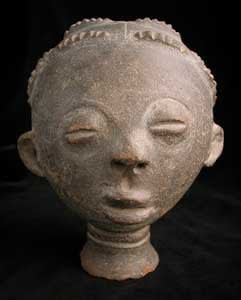Akan Terracotta Funerary Head, 16th Century CE - 18th Century CE
Terracotta
height 22.2 cm
height 8 3/4 in
height 8 3/4 in
PF.6290
Further images
Among the funerary rituals of the ancient Akan peoples are ceramic sculptures dedicated to the memory of their ancestors that served as grave markers. Although these ceramic sculptures are sometimes...
Among the funerary rituals of the ancient Akan peoples are ceramic sculptures dedicated to the memory of their ancestors that served as grave markers. Although these ceramic sculptures are sometimes full figures, they are more often just heads. These heads are thought to commemorate royalty. Sometimes they are placed in special shrines where they receive annual libations. However, most of them appear to have been placed in or in the direct vicinity of cemeteries. Frequently labeled as “portraits,” they are not in the Western understanding of the word. Only some features, such as hairstyles and scarifications, are specifically related to the deceased. Yet these features would be sufficient for his relative to recognize him by. The massive volume of the head projects vitality, and the partially drawn eyelids show this person is in a trance. The mouth is open, and seems to smile at us. The gaze of the deceased is frozen in time in an expression that neither speaks nor is silent. Before being placed as a grave marker, these heads would be used in ceremonies pertaining to the deceased. These ceremonies would often last as long as forty days or until the dead had achieved ancestral status through the rituals. Gazing upon this head we are confronted with the image of a parted soul. While upon death our bodies decompose and leave behind skeletal remains of our physical being, this small terracotta head is the skeleton of the spirit. It honors not the body, not the physical presence of a person, but the entire essence of their being.









